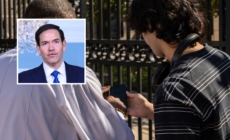-
U.S. Strike on Iran Would Bring Risks at Every Turn - 22 mins ago
-
The Vicious Campaign Against Meghan Markle Must End | Opinion - 35 mins ago
-
L.A. street life ‘paralyzed’ as ICE raids keep shoppers away, close businesses - 44 mins ago
-
When Humans Learned to Live Everywhere - about 1 hour ago
-
Minnesota Could Put Property Tax Rise to Voters - about 1 hour ago
-
Pokémon GO’s Future? Night Events and Country Specific Pokémon, Says Dev - 2 hours ago
-
Karen Read Acquitted in Murder Trial Over Boyfriend’s Death Outside Boston - 2 hours ago
-
State Department Reveals Changes for Student Visa Applicants - 2 hours ago
-
Food Network Chefs Pay Tribute to Anne Burrell - 3 hours ago
-
Scorpion Venom Could Help Treat Breast Cancer - 3 hours ago
Purpose-Driven Innovation: Beyond the Hospital, a Human Experience
Innovating in health care means, above all, daring to imagine and build a new way of caring—one where every decision is guided by the purpose of transforming lives and communities. At the Fundación Cardiovascular de Colombia (FCV) and the Hospital Internacional de Colombia (HIC), this has been our commitment: to develop a model that transcends the clinical and embraces the complexity of the human being, integrating science, culture, empathy and international vision at every step – from a holistic approach to healing to the bespoke AI-powered systems we’ve developed in-house.
Among our most distinctive innovations are AI-powered tools that bring intelligence and precision to every level of care. These include SAHI Smart, a voice-recognition system that streamlines medical consultations by enabling natural interaction between doctors and patients while automatically generating clinical records and supporting diagnosis; MOE, a real-time monitoring platform that helps prevent adverse events like falls or pressure injuries and offers predictive insights into clinical and administrative trends; and smart monitoring centers that centralize data to optimize hospital operations. Together, these technologies enhance safety, efficiency and the overall care experience.
An Environment That Heals and Humanizes
From its conception, the HIC was designed not to feel like a traditional hospital. Walking through its spaces reveals environments that invite serenity and hope: indoor gardens, murals, reading rooms, artwork on the walls and even a piano in the lobby. These elements are not decorative; they are active parts of the healing process. The presence of the “Letras de vida” library, designed to offer comfort and distraction, along with in-hospital classrooms for children, guided by educators, are examples of how the environment can support patients’ emotional and physical recovery.
Art, music and culture are integrated into the hospital experience through activities organized in collaboration with local institutions. These initiatives not only enrich the lives of those undergoing treatment but also transform the hospital into a space for collective learning and community, where health is understood as a state of holistic well-being.

Interdisciplinary Care and Patient-Centered Attention
The true center of our model is the patient, understood in their full human dimension. Interdisciplinary care is fundamental: doctors, nurses, psychologists, nutritionists, social workers and therapists come together to design individualized care plans that consider both clinical and emotional or social needs. The patient experience office coordinates each stage of the process, from admission to discharge, ensuring that the family is involved and emotional and practical support is continuous.
Each room is equipped with entertainment platforms offering television, music and educational content, allowing patients to choose what brings them comfort and companionship during their stay. In addition, access to a healing garden and views of the natural surroundings allow patients to breathe fresh air and contemplate open landscapes. Far from being mere amenities, these elements are essential for reducing stress, improving treatment adherence and contributing to faster, more complete recovery.
Technology, Sustainability and Replicability
Located in Bucaramanga, a dynamic city that has become a regional center for services and knowledge, the facilities and its staff understand that innovation is not optional, but a strategic necessity to respond to the challenges of our environment. With the creation of the HIC, we took a decisive step: We implemented Colombia’s first intelligent digital hospital, one of the most advanced in Latin America, integrating clinical automation, Internet of Things (IoT), efficient energy management, digital bed control and geolocation of medical equipment.
This infrastructure, developed under international standards and validated by the Healthcare Information and Management Systems Society (HIMSS), not only optimizes internal processes but directly impacts patient safety, efficiency and well-being. It allows us to anticipate needs, reduce critical timeframes and provide more personalized care. In this sense, digital transformation is not an end in itself but a tool to make each hospital experience more human, precise and safe.
The upcoming implementation of drones to deliver medications and samples to nearby municipalities represents a significant advance that will optimize critical timeframes and logistical efficiency within our care network. Our in-house development, SAHI Smart, is a voice-recognition and AI-based intelligent system that transforms the medical consultation into a space centered on doctor-patient conversation, while automating the clinical record, diagnosis and treatment documentation. Meanwhile, the MOE platform specializes in predictive analysis of clinical and administrative indicators, facilitating decision-making and anticipating operational needs. These developments are concrete examples of how innovation can align with humanization and sustainability in the hospital environment.
Each innovation is evaluated based on cost-benefit analysis, and sustainability is ensured by reinvesting the surpluses generated by our operations. Additionally, FCV promotes ethical knowledge dissemination and best practices, sharing protocols and developments with other institutions to multiply social impact and contribute to sector transformation.

Research and Development
Our research journey spans a wide range of medical specialties and topics—from cardiology, neurology, oncology, orthopedics, nephrology and digestive health to rehabilitation strategies, telemedicine, hospital management innovation and humanization programs that incorporate cultural and artistic activities for patient well-being. The results of these investigations are published in international scientific journals and presented at global conferences, positioning Colombia as a reference in hospital innovation and facilitating knowledge transfer to other contexts.
Our international vision is realized through strategic partnerships with institutions around the world, knowledge exchanges and the training of human talent capable of competing and collaborating globally. We have treated patients from various countries, shared best practices and participated in international research networks, contributing to global health and demonstrating that excellence can emerge from any setting, even mid-size cities.
Social Impact: Bridging Gaps and Expanding Access
Health care innovation only makes sense when it generates positive and tangible social impact. We have worked to reduce access gaps by bringing high-complexity care to historically underserved regions and creating community programs for prevention and education. Telemedicine and remote monitoring have allowed us to deliver cardiovascular care to municipalities without cardiologists, avoiding costly and risky transfers for vulnerable patients.
The HIC’s digital platform facilitates online consultations, test results, appointments, payments and remote rehabilitation programs, reducing barriers and improving continuity of care. Each technological and organizational advancement has been calibrated to ensure sustainable and replicable impact, enabling other health systems to adopt and adapt our solutions to their specific realities.
Our commitment to equity and social justice is unwavering. We know that technology and innovation only matter when they improve people’s lives, especially the most vulnerable. That is why every project, device and protocol is evaluated not only for clinical efficacy but also for its potential to positively transform the lives of patients and their families.

Organizational Culture: Leadership With Vision and Heart
Human talent is our greatest asset and the primary driver of innovation. From recruitment and training to retention, we aim to develop well-rounded professionals who see themselves as part of a purposeful project. Our organizational culture is based on strong values: service, innovation and commitment. We celebrate achievements—clinical, scientific and cultural—in assemblies and publications, and we share daily life through social media and internal spaces to strengthen a sense of belonging and motivation.
Leadership in health care must be approachable: the director who attends training sessions, the doctor who adjusts the waiting room, the nurse who suggests improvements to clinical flow design. Listening, being present and valuing the team’s ideas are fundamental pillars in building an environment where innovation arises from daily commitment and a passion for service.
Global Vision with Local Impact
The HIC model demonstrates that it is possible to innovate with purpose, combining technology, culture and humanity for the benefit of those who need it most. Our experience is proof that excellence can emerge from any context and that sustainable, replicable models are key to tackling 21st-century health care challenges.
Today, more than ever, the world needs organizations capable of combining international vision with tangible social impact. Health care innovation, when built with heart and commitment, transcends borders and leaves a lasting mark on the lives of people and communities. That is the true power of purpose-driven innovation in health: to transform the human experience, to inspire others and to show that even in contexts full of barriers, it is possible to build excellence and hope.
Source link




















